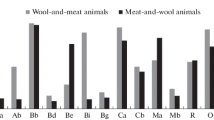Abstract
Seventeen blood proteins were studied in a sample of 412 Spanish wild rabbits and in 598 domestic rabbits belonging to various breeds. The wild rabbit populations showed a high level of genetic polymorphism. Six loci were monomorphic, while the remaining ten loci were segregating for at least two alleles. Two of the loci that were polymorphic in the wild rabbits were monomorphic in the domestic ones. Wright's inbreeding coefficient in the total Spanish wild rabbit population was F=5.66, indicating subdivision of the total population. Inbreeding coefficients, estimated by Kidd et al.'s method (Anim. Blood Grps, Biochem. Genet. 11: 21–38), differed significantly from zero, being 15.62%, in wild rabbits and 6–12% in domestic breeds, indicating consanguinity.
Genetic distances between wild rabbit populations showed that factors other than geographic distance (e.g., bottlenecks, barriers such as rivers, mountains, etc.) may explain the result that a northern population forms a cluster with two central populations whereas the northeastern populations form a different cluster with another central population. Populations of the first cluster are more closely related to the captive populations than others.
There are three population clusters of domestic rabbits, namely (1) New Zealand White and a hybrid combination; (2) Spanish Common, Butterfly, Burgundy, and Californian; and (3) Spanish Giant.
Similar content being viewed by others
References
Arana, A. & Zaragoza, P., 1986. Estudios electroforéticos de la especie Oryctolagus cuniculus (L.) (razas silvestre y Común español). Genet. iber. 38: 245–263.
Arana, A., Zaragoza, P., Rodellar, C. & Amorena, B., 1987. Contribution of the Spanish wild rabbit biochemical polymorphism to the gene pool: A new haemoglobin variant. Rabbit Res. 10, no 2: 85–87.
Bernoco, D., 1969. Electrophoretic variants of carbonic anhydrases in rabbit red cells. Atti. Ass. genet. ital. 15: 226–227.
Binette, J. P., 1976. Enzymes and other proteins in serum and tissues: Rabbit. In: Inbred and genetically defined strains of laboratory animals. Part 2. Hamster, Guinea Pig, Rabbit and Chicken: 578–590: P. L. Altman & D. Ditterd. Biological Handbook, Bethesda.
Cavalli-Sforza, L. L. & Edwards, A. W. F., 1967. Phylogenetic analysis: Models and estimations procedures. Am. J. hum. Genet 19: 233–257.
Coggan, M., Bahwin, J. & Richardson, B. J., 1974. Ecological genetics of the wild rabbit in Australia. I. Geographical distribution and biochemical characterization of phosphogluconate dehydrogenase variants. Aust. J. biol. Sci. 27: 671–675.
Dayhoff, M. O., 1972. Atlas of protein sequence and structure. Vol. 5. Nat. Biomed. Res. Found. Silver. Spring. Maryland.
Edwards, A. W. F., 1971. Mathematical approaches to the study of human evolution. Mathematics in the archaelogical and historical sciences. Hudson, Edinburgh.
Grunder, A. A., 1966. Inheritance of a hemo-binding protein in rabbits. Genetics 54: 1085–1093.
Grunder, A. A., Sartore, G. & Stormont, C., 1965. Genetic variation in red cell esterases of rabbits. Genetics 52: 1345–1353.
Hagen, K. L., Suzuki, Y., Tissot, R. & Cohen, C., 1978. The hemopexin locus: Its assignment to linkage Group I in the laboratory rabbit (Oryctolagus cuniculus) and evidence for a fourth allele. Anim. Blood Grps. biochem. Genet. 9: 151–159.
Juneja, R. K., Wan De Weghe, A. & Gahne, B., 1981. A new genetically determined plasma protein polymorphism in the laboratory rabbit. Hereditas 94: 245–246.
Kidd, K. K., Stone, W. H., Crimella, C., Carenzi, C., Casati, M. & Rognoni, G., 1980. Immunogenetic and population genetic analyses of Iberian cattle. Anim. Blood Grps. biochem. Genet. 11: 21–38.
Larruga, J. M., Cabrera, M. V., González, A. M. & Gullón, A., 1983. Molecular and chromosomal polymorphism in continental and insular populations from the southwestern of Drosophila subobscura. Genetica 60: 191–205.
Nei, M., 1972. Genetic distance between populations. Am. Nat. 106: 282–292.
Peluso, F., Valerio, D. & Salermo, R., 1982. Enzyme activity and 6-Pgd genetic variants in rabbit. In: XVIIIth Int. Conf. Anim. Blood Groups Biochem. Polymorphs. Animal Diseases Res. Institute. Ottawa.
Richardson, B. J., 1980. Ecological genetics of the wild rabbit in Australia. III. Comparison of the microgeographical distribution of alleles in two different environments. Aust. J. Biol. Sci. 33: 385–391.
Richardson, B. J., Rogers, P. M. & Hens, G. M., 1980. Ecological genetics of the wild rabbit in Australia. II. Protein variation in British, French and Australian rabbits and the geographical distribution of the variation in Australian. Aust. J. biol. Sci. 33: 371–383.
Robinson, T. J. & Osterhoff, D. R., 1983. Protein variation and its systematic implications for the South-African Leporidae (Mammalia: Lagomorpha). Anim. Blood Grps. biochem. Genet. 14: 139–149.
Rolls, E., 1969. They all ran wild. Angus & Robertson, Sydney.
Schiff, R. & Stormont, C., 1970. The biochemical genetics of rabbit erythrocyte esterases: two new esterase loci. Biochem. Genet. 4: 11–23.
Sokal, R. R. & Sneath, P. H. A., 1953. Principles of numerical taxonomy. Freeman, San Francisco.
Suzuki, Y. & Stormont, C., 1972. A third allele in the Es-3 system of rabbit blood esterase. In: XIIth Int. Conf. Anim. Blood Groups Biochem. Polymorphs. Research Institute for Animal Husbandry. Budapest.
Vergnes, M., Puget, A. & Gonardese, C., 1974. Comparative study of red cell enzyme polymorphism in the pika and the rabbit. Anim. Blood Grps. biochem. Genet. 5: 181–188.
Wright, S., 1943. Isolation by distance. Genetics 28: 114–138.
Zaragoza, P., Arana, A., Zaragoza, I. & Amorena, B., 1985. Polimorfismos bioquimicos sanguineos en las razas de conejo Común español y Gigante de España. Aportaciones metodológicas y control genético. Genet. iber. 37: 107–134.
Zaragoza, P., Arana, A., Zaragoza, I. & Amorena, B., 1987. Blood biochemical polymorphisms in rabbits presently bred in Spain. Genetic variation and distances amongst populations. Aust. J. biol. Sci. 40: 1–12.
Zaragoza, P., Arana, A. & Amorena, B., 1987. Relationship between rabbit transferrin electrophoretic patterns and plasma iron concentrations. Anim. Genet. 18: 51–62.
Author information
Authors and Affiliations
Rights and permissions
About this article
Cite this article
Arana, A., Zaragoza, P., Rodellar, C. et al. Blood biochemical polymorphisms as markers for genetic characteristics of wild Spanish and domestic rabbits. Genetica 79, 1–9 (1989). https://doi.org/10.1007/BF00056059
Received:
Accepted:
Issue Date:
DOI: https://doi.org/10.1007/BF00056059



